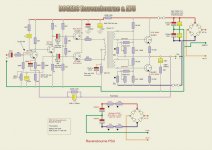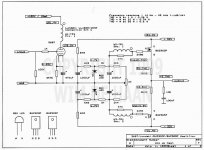about other amp circuits an interstage transformer
Many amplifiers designs did use an interstage transformer, for example the Rogers Ravensbourne, if am I correct an amplifier of the late 60s.
Enclosed the circuit. This amp is using 2x NPN power transistor in the output stage. Specs of this amp are rather good.
I did build my first interstage coupled amp in 1998 or so (after an idea of Guido Tent) and at that time I collected lots of circuits of amps using an interstage transformer.
Many amplifiers designs did use an interstage transformer, for example the Rogers Ravensbourne, if am I correct an amplifier of the late 60s.
Enclosed the circuit. This amp is using 2x NPN power transistor in the output stage. Specs of this amp are rather good.
I did build my first interstage coupled amp in 1998 or so (after an idea of Guido Tent) and at that time I collected lots of circuits of amps using an interstage transformer.
Attachments
Many amplifiers designs did use an interstage transformer, for example the Rogers Ravensbourne, if am I correct an amplifier of the late 60s.
Enclosed the circuit. This amp is using 2x NPN power transistor in the output stage. Specs of this amp are rather good.
I did build my first interstage coupled amp in 1998 or so (after an idea of Guido Tent) and at that time I collected lots of circuits of amps using an interstage transformer[who was first to make this type of amp?]
Thank you again wimdehaan. buzzforb: the primary winding of the transformer is driven in a differential manner by two bjts of low output impedance; because they are operating in the common collector configuration. One could even consider this front end a modest Op Amp.
correct me if I'm wrong - you had on your site page about OM961 based amps
Yes, that's correct, but that's a long time ago and info is no longer on the site. But if any question, please do send me a pm, and will see if I can answer it.
[who was first to make this type of amp?]
Guido Tent only put it on paper, he never build it. For this reason it was not noticed that the circuit had some minor (but essential) mistakes. I build and tested the 'real' thing using a 5687 tube and an Lundahl interstage transformer.
ZM: I fully agree with you that the transformer in the Tango schematic is not a ground loop isolator per the underlined. By contrast, the Jensen in Conceptual F6 will operate like a ground loop isolator because the CD player [could be battey operated] or other input source [that of Rush] and the power amp have independent grounds. And there is no reason [electrical, performance] to join these grounds either.some xformer based gadgets are made exactly for that ;
but , every other xformer based gadget (or part of bigger gadget,mix console for instance) is made with some other primary purpose and , depending how xformer is wired , can bring that virtue , or not .
so , in case of MJ schematic ...... it's not (real) gnd-breaker , because you have same gnd connected in circ on both sides of xformer
wimdehaan: Is he still alive? Where is his famous paper, and did it show a date of conception? Will it be proper to refer to the circuits you've posted and others like it as [or based on] the "Guido Tent" design?Guido Tent only put it on paper, he never build it. For this reason it was not noticed that the circuit had some minor (but essential) mistakes. I build and tested the 'real' thing using a 5687 tube and an Lundahl interstage transformer.
wimdehaan, a name many would recognize 🙂
I believe I know the circuit and I have taken the idea myself for adoption into my next project.
This one?
I believe I know the circuit and I have taken the idea myself for adoption into my next project.
This one?
Attachments
Last edited:
wimdehaan: Is he still alive? Where is his famous paper,
If I am still alive? I guess I am, otherswise someone else is using the same name 😀
I am not aware of any famous paper, on my website it was mentioned it was after an idea of Guido Tent, and realization by me. It was me who choose for the 5687 tube, the Lundahl LL1660 and Magnated power mosfets, the corrections came also from me. FLG did upload the circuit, this is a very early one, the 'real' drawing is a little different, the gray text was deleted.
In a way I gave up on diyaudio.com, after my Elektor Mugen design and publication some members really gave me a hard time, this in a not respectfull way, I know its part of all, but still. Once in the while I still get an email (like a few days ago regarding my DC coupled EL84 design) of diyaudio.com and clicked also Nelson Pass and this F6 thread.
Last edited:
flg: count me in to have the pleasure of recognizing wimdehaan and his valuable contributions. ZM: Maybe Jason and other luminaries extend a diyAudio Honorary Membership to wimdehaan and Guido Tent. Together [inadvertently] with Mr. Pass, they have stirred excitement, buzz and therapy in the F6 Amplifier thread. Ironic if Mr. Guido Tent is a regular visitor of this thread. I hope he does show up.wimdehaan, a name many would recognize 🙂
I believe I know the circuit and I have taken the idea myself for adoption into my next project.
This one?
Last edited:
ZM: I fully agree with you that the transformer in the Tango schematic is not a ground loop isolator per the underlined. By contrast, the Jensen in Conceptual F6 will operate like a ground loop isolator because the CD player [could be battey operated] or other input source [that of Rush] and the power amp have independent grounds. And there is no reason [electrical, performance] to join these grounds either.
as shown in post #1 ( and later , revised schm) :
-output of amp is referenced to gnd via PSU and NFB
-bottom of Jensen's primary is referenced to gnd
so - how is Jensen gnd breaker ?
only if you exclude NFB , there is no galvanic connection between input and OS
ZM: I fully agree with you. My past comments and this one are the same. They pertained to operating the output stage of a modified Conceptual F6 in an open loop manner only [the underlined].as shown in post #1 ( and later , revised schm) :
-output of amp is referenced to gnd via PSU and NFB
-bottom of Jensen's primary is referenced to gnd
so - how is Jensen gnd breaker ?
only if you exclude NFB , there is no galvanic connection between input and OS
What seems to be true is that the FE and output stage can be top notch without much trouble, but the important components will be the xformer and caps. I am going to try my big honking caps. If they need bypass, I will do so. I have the SS fets now( Thanks Tea) and will b using an ADC transformer and a BudP Onetics version as well. Guess we will see. I am excited, don't know about anybody else.
I already told ya - I like Romance

so - if ya need any help , or just feel lack of mocking , just buzz


so - if ya need any help , or just feel lack of mocking , just buzz

Guido Tent only put it on paper, he never build it. For this reason it was not noticed that the circuit had some minor (but essential) mistakes. I build and tested the 'real' thing using a 5687 tube and an Lundahl interstage transformer.
The underlined suggests a name for the general Classic design which Mr. Pass wrote about in the early posts of the F6 Amplifier thread. It is the "wimdehaan-Tent Circuit". The family name of diyAudio member wimdehaan [like Tent] is not on record.
I share your excitement and will celebrate your success. I am unable to tell which schematic you are using. Maybe in good time!What seems to be true is that the FE and output stage can be top notch without much trouble, but the important components will be the xformer and caps. I am going to try my big honking caps. If they need bypass, I will do so. I have the SS fets now( Thanks Tea) and will b using an ADC transformer and a BudP Onetics version as well. Guess we will see. I am excited, don't know about anybody else.
Will there be an F6 Turbo? 🙂
Scaling the output is pretty straightforward. More rail voltage, more fets. I think ZM suggested the FE could drive about 3 pairs. Of course the FE could be scaled as well.
- Home
- Amplifiers
- Pass Labs
- F6 Amplifier

